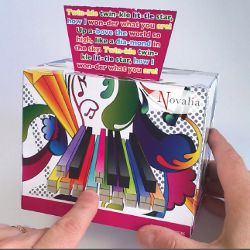
Bored with the daily read in your local newspaper? The paper you touch and read every day could become a lot more interesting — and not just when you crack open a periodical or tabloid. At least, it will if Kate Stone has her way. Stone, founder and managing director of technology company Novalia, is developing market-ready interactive print technology.
"We have electronics everywhere. They’re all around us," Stone says. "And we have print everywhere — it’s the human user interface of choice. Imagine if you put the functionality of electronics into print."
The technology Stone is developing does just that. She uses conductive inks to turn normal print into an interactive medium that responds to a user’s touch. Printed using conventional printing techniques, interactive print is connected through conductive tracks to small, conventional silicon chips embedded in the paper. These chips contain software written by Novalia that can carry out an array of actions.
"You can touch the print, and the print knows you’ve touched it," she says.
For instance, Stone demonstrated at a TED talk how her company put a picture of a keyboard on the side of a tissue box. The keyboard was inked in interactive print. When each key was touched, it played a corresponding note through speakers embedded in the paper. Stone has also connected the software, conductive ink, and chips used in interactive print to the Internet via Bluetooth chips embedded in the paper. At a talk at the Festival of Media Global 2012, she showcased a poster for a jazz concert with pictures of instruments. Tapping each instrument sent a signal to Stone’s iPad, which broadcast a song played by the corresponding instrument.
Stone, who has a degree in electronics from Salford University and a Ph.D. in physics from Cambridge, started experimenting with interactive print technology in her garage. Novalia, the company she built to continue her work with interactive print, now has nine employees and is actively working with companies in diverse industries to implement the technology. So far, she says, everyone from medical companies to toy manufacturers to media firms has expressed interest in the technology.
"We are trying to keep the platform [of interactive print] common," says Stone, "We don’t want to create our own products: we want to create a platform that’s inherently easy for manufacturers and designers to use. There’s no way we can pick the right market or the right application for this technology."
Instead, Stone and Novalia are looking to standardize the processes, software, and tools used to create interactive print and partner with firms to implement it. Because the process works like traditional printing, not only can it be applied to any industry that uses printed materials, it can also scale like any other mass-print production.
"We can print about 10,000 to 15,000 sheets [of interactive print] an hour," Stone says.
However, there are challenges. While printing the conductive ink is as easy as printing on conventional paper, Novalia is still working on automating the process of embedding the silicon chips into the interactive printed material.
Stone seems up to the challenge. After all, she didn’t know where the project would go when she started tinkering in her garage: she just knew it was something new and unconventional.
Going against the grain has been influenced, in part, by Stone’s personal journey. Stone is transgender, and that identity taught her some important lessons that also apply to the uncharted territory of interactive print.
"One thing we have in common is that we’re all different," Stone says. "But most of us don’t dare to be different, which is about doing what we feel is right, rather than doing what we think everyone else expects us to do. That’s a huge challenge."
If Novalia’s efforts pan out, the entire print world might start doing things differently. And Stone is ready to see just how that plays out.
"When I started this, I didn’t really know what I was doing," she says. "I just knew that what I wanted to do was different from what everyone else around me was doing."



Join the Discussion (0)
Become a Member or Sign In to Post a Comment